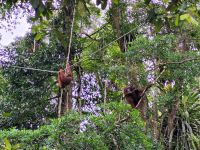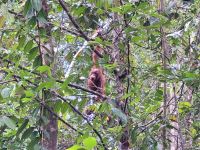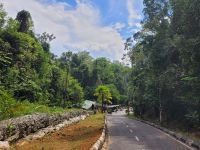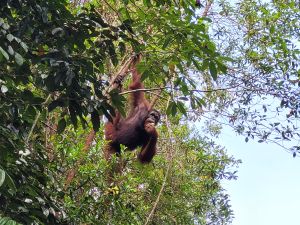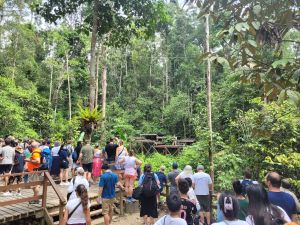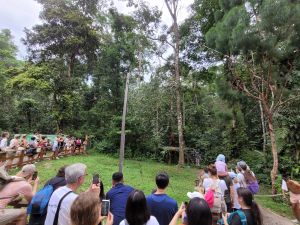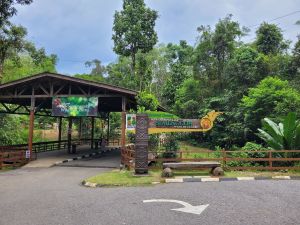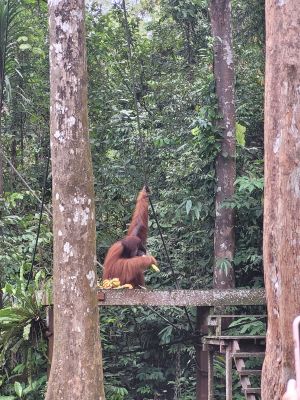Difference between revisions of "Semenggoh Nature Reserve"
| (8 intermediate revisions by the same user not shown) | |||
| Line 10: | Line 10: | ||
= Summary = <!-- An overview of the site, with one sentence for each section. May include a site map --> | = Summary = <!-- An overview of the site, with one sentence for each section. May include a site map --> | ||
| + | <div style="float: right"> | ||
| + | {{#display_map: height=200px | width=300px | scrollzoom=off | zoom=5 | layers= OpenStreetMap, OpenTopoMap | ||
| + | |1.392031, 110.299506~[[Semenggoh Nature Reserve]]~Northwest Bornean orangutans | ||
| + | }} | ||
| + | </div> | ||
* Northwest Bornean orangutans (''Pongo pygmaeus pygmaeus'') are present in Semenggoh Nature Reserve. | * Northwest Bornean orangutans (''Pongo pygmaeus pygmaeus'') are present in Semenggoh Nature Reserve. | ||
* 27 individuals occur in the site. | * 27 individuals occur in the site. | ||
| Line 18: | Line 23: | ||
* Semi-wild orangutans inhabit the site. | * Semi-wild orangutans inhabit the site. | ||
<div><ul> | <div><ul> | ||
| − | <li style="display: inline-block;">[[File: | + | <li style="display: inline-block;"> [[File: Orangutan_Semenggoh.jpg | 200px | thumb| right | © Isabel Ordaz-Nemeth]] |
| − | + | <li style="display: inline-block;"> [[File: Orangutan2_Semenggoh.jpg | 200px | thumb| right | © Isabel Ordaz-Nemeth]] | |
| − | <li style="display: inline-block;"> [[File: Orangutan2_Semenggoh. | + | <li style="display: inline-block;"> [[File: road_Semenggoh.jpg | 200px | thumb| right | Road to visitor center © Isabel Ordaz-Nemeth]] |
| − | <li style="display: inline-block;"> [[File: road_Semenggoh. | ||
</ul></div> | </ul></div> | ||
= Site characteristics = <!-- A paragraph summary of physical and geographic aspects of the site, and a table of key information --> | = Site characteristics = <!-- A paragraph summary of physical and geographic aspects of the site, and a table of key information --> | ||
| − | + | [[File: Orangutan_eating_Semenggoh.jpg | 300px | thumb| right | © Isabel Ordaz-Nemeth]] | |
The nature reserve is located in the Malaysian state of Sarawak, in the northwest of Borneo. The site was first designated as a Forest Reserve in 1920 and subsequently used as a botanical research plot ([https://semenggoh.my/about-us/ SFC]). In 1975 the Semenggoh Wildlife Rehabilitation Centre was established as part of the reserve, with the aim of rehabilitating orangutans and other wildlife species in Sarawak ([https://semenggoh.my/about-us/ SFC]). Semenggoh Forest Reserve was declared as Semenggoh Nature Reserve in 2000. In the same year, the Wildlife Rehabilitation Centre was renamed as the Semenggoh Wildlife Centre. The name is derived from the Semenggoh river, which runs through the reserve. Semi-wild orangutans inhabit the site; they spend most of the time roaming freely in the forest, but occasionally visit feeding platforms that are provisioned daily. In addition to orangutans, the site is also home to giant squirrels, pygmy squirrels, gibbons and a wide variety of birds ([https://semenggoh.my/about-us/ SFC]). | The nature reserve is located in the Malaysian state of Sarawak, in the northwest of Borneo. The site was first designated as a Forest Reserve in 1920 and subsequently used as a botanical research plot ([https://semenggoh.my/about-us/ SFC]). In 1975 the Semenggoh Wildlife Rehabilitation Centre was established as part of the reserve, with the aim of rehabilitating orangutans and other wildlife species in Sarawak ([https://semenggoh.my/about-us/ SFC]). Semenggoh Forest Reserve was declared as Semenggoh Nature Reserve in 2000. In the same year, the Wildlife Rehabilitation Centre was renamed as the Semenggoh Wildlife Centre. The name is derived from the Semenggoh river, which runs through the reserve. Semi-wild orangutans inhabit the site; they spend most of the time roaming freely in the forest, but occasionally visit feeding platforms that are provisioned daily. In addition to orangutans, the site is also home to giant squirrels, pygmy squirrels, gibbons and a wide variety of birds ([https://semenggoh.my/about-us/ SFC]). | ||
| Line 182: | Line 186: | ||
<div><ul> | <div><ul> | ||
| − | <li style="display: inline-block;"> [[File: Main_platform_Semenggoh. | + | <li style="display: inline-block;"> [[File: Main_platform_Semenggoh.jpg | 300px | thumb| right | View to feeding platforms © Isabel Ordaz-Nemeth]] |
| − | <li style="display: inline-block;"> [[File: Tourists_Semenggoh. | + | <li style="display: inline-block;"> [[File: Tourists_Semenggoh.jpg | 300px | thumb| right | © Isabel Ordaz-Nemeth]] |
| − | <li style="display: inline-block;"> [[File: visitor_center_Semenggoh. | + | <li style="display: inline-block;"> [[File: visitor_center_Semenggoh.jpg | 300px | thumb| right |© Isabel Ordaz-Nemeth]] |
</ul></div> | </ul></div> | ||
| − | A rehabilitation program for orangutans was created at the site in 1975. By 1990 there was a growing population of semi-wild orangutans. Due to the small size of the site, the rehabilitation program was moved to Matang Wildlife Centre in 1998 | + | A rehabilitation program for orangutans was created at the site in 1975. By 1990 there was a growing population of semi-wild orangutans. Due to the small size of the site, the rehabilitation program was moved to Matang Wildlife Centre in 1998. The wildlife centre is active in conservation awareness and education for schools and the public (Tisen & Silang 2016). |
'''Table 4. Conservation activities in Semenggoh Nature Reserve''' | '''Table 4. Conservation activities in Semenggoh Nature Reserve''' | ||
| Line 233: | Line 237: | ||
|8. Invasive & other problematic species, genes, diseases | |8. Invasive & other problematic species, genes, diseases | ||
|8.9. Limit time that researchers/tourists are allowed to spend with habituated animals | |8.9. Limit time that researchers/tourists are allowed to spend with habituated animals | ||
| − | |||
|Tourists are only allowed to watch orangutans twice a day for two hours each time (Azizi Bin Ahmad Zaini pers. comm. 2023). | |Tourists are only allowed to watch orangutans twice a day for two hours each time (Azizi Bin Ahmad Zaini pers. comm. 2023). | ||
|Ongoing (2023) | |Ongoing (2023) | ||
| Line 281: | Line 284: | ||
= Challenges = <!-- Overview of challenges in ape conservation --> | = Challenges = <!-- Overview of challenges in ape conservation --> | ||
| − | [File: feeding_platform_Semenggoh. | + | [[File: feeding_platform_Semenggoh.jpg | 300px | thumb| right |© Isabel Ordaz-Nemeth]] |
Ecotourism at the site brings both benefits and challenges; the main challenge is to ensure large numbers of tourists stay at the permitted distance from orangutans in the occasions when orangutans appear by the road in the reserve and not on the feeding platforms (Azizi Bin Ahmad Zaini pers. comm. 2023). | Ecotourism at the site brings both benefits and challenges; the main challenge is to ensure large numbers of tourists stay at the permitted distance from orangutans in the occasions when orangutans appear by the road in the reserve and not on the feeding platforms (Azizi Bin Ahmad Zaini pers. comm. 2023). | ||
| Line 322: | Line 325: | ||
<br> | <br> | ||
| − | '''Page completed by: '''A.P.E.S. Wiki team''' Date:''' 14/09/2023 <!-- If you don't want to add your name, you can add "A.P.E.S. Wiki team" --> | + | '''Page completed by: '''Muhammad Azizi Bin Ahmad Zaini & A.P.E.S. Wiki team''' Date:''' 14/09/2023 <!-- If you don't want to add your name, you can add "A.P.E.S. Wiki team" --> |
Latest revision as of 03:22, 18 September 2023
Asia > Malaysia > Semenggoh Nature Reserve
Summary
- Northwest Bornean orangutans (Pongo pygmaeus pygmaeus) are present in Semenggoh Nature Reserve.
- 27 individuals occur in the site.
- The orangutan population trend is stable.
- The site has a total size of 6.53 km².
- Key threats to orangutans are habitat encroachment and hunting.
- Conservation activities have focused on orangutan rehabilitation, ecotourism, raising awareness and education.
- Semi-wild orangutans inhabit the site.
Site characteristics
The nature reserve is located in the Malaysian state of Sarawak, in the northwest of Borneo. The site was first designated as a Forest Reserve in 1920 and subsequently used as a botanical research plot (SFC). In 1975 the Semenggoh Wildlife Rehabilitation Centre was established as part of the reserve, with the aim of rehabilitating orangutans and other wildlife species in Sarawak (SFC). Semenggoh Forest Reserve was declared as Semenggoh Nature Reserve in 2000. In the same year, the Wildlife Rehabilitation Centre was renamed as the Semenggoh Wildlife Centre. The name is derived from the Semenggoh river, which runs through the reserve. Semi-wild orangutans inhabit the site; they spend most of the time roaming freely in the forest, but occasionally visit feeding platforms that are provisioned daily. In addition to orangutans, the site is also home to giant squirrels, pygmy squirrels, gibbons and a wide variety of birds (SFC).
Table 1. Basic site information for Semenggoh Nature Reserve
| Area | 6.53 km² |
| Coordinates | 1.392031, 110.299506 |
| Designation | Nature Reserve |
| Habitat types | Subtropical/tropical moist lowland forest |
IUCN habitat categories Site designations
Ape status
Table 2. Ape population estimates in Semenggoh Nature Reserve
| Species | Year | Abundance estimate (95% CI) | Density estimate [ind./ km²] (95% CI) | Encounter rate (nests/km) | Area | Method | Source | Comments | A.P.E.S. database ID |
|---|---|---|---|---|---|---|---|---|---|
| Pongo pygmaeus pygmaeus | 2016 | 27 | Semenggoh Nature Reserve | Full count | Tisen & Silang 2016 | ||||
| Pongo pygmaeus pygmaeus | 2023 | 29 | Semenggoh Nature Reserve | Full count | Azizi Bin Ahmad Zaini pers. comm. 2023 |
Threats
Table 3. Threats to apes in Semenggoh Nature Reserve
| Category | Specific threats | Threat level | Quantified severity | Description | Year of threat |
|---|---|---|---|---|---|
| 1. Residential & commercial development | 1.1 Housing & urban areas | High | Habitat encroachment due to housing developments around the site, which also increase forest fragmentation (Ali 2021). | Ongoing (2021) | |
| 2. Agriculture & aquaculture | Unknown | ||||
| 3. Energy production & mining | Unknown | ||||
| 4. Transportation & service corridors | Unknown | ||||
| 5. Biological resource use | 5.1 Hunting & collecting terrestrial animals | Present, but threat severity unknown | Poaching (Ali 2021). | Ongoing (2021) | |
| 6. Human intrusion & disturbance | Unknown | ||||
| 7. Natural system modifications | Unknown | ||||
| 8. Invasive & other problematic species, genes, diseases | 8.5 Viral/prion-induced diseases | Present, but threat severity unknown | Risk of infection due to human presence, including Covid-19 (Ali 2021), and pulmonary diseases (Azizi Bin Ahmad Zaini pers. comm. 2023). | Ongoing (2023) | |
| 9. Pollution | Unknown | ||||
| 10. Geological Events | Absent | ||||
| 11. Climate change & severe weather | Unknown | ||||
| 12. Other options | Absent |
Conservation activities
A rehabilitation program for orangutans was created at the site in 1975. By 1990 there was a growing population of semi-wild orangutans. Due to the small size of the site, the rehabilitation program was moved to Matang Wildlife Centre in 1998. The wildlife centre is active in conservation awareness and education for schools and the public (Tisen & Silang 2016).
Table 4. Conservation activities in Semenggoh Nature Reserve
| Category | Specific activity | Description | Year of activity |
|---|---|---|---|
| 1. Residential & commercial development | Not reported | ||
| 2. Agriculture & aquaculture | Not reported | ||
| 3. Energy production & mining | Not reported | ||
| 4. Transportation & service corridors | Not reported | ||
| 5. Biological resource use | 5.6. Conduct regular anti-poaching patrols | Regular patrols to monitor orangutans, secure the reserve from trespassing and poaching (Azizi Bin Ahmad Zaini pers. comm. 2023). | Ongoing (2023) |
| 6. Human intrusion & disturbance | Not reported | ||
| 7. Natural system modifications | Not reported | ||
| 8. Invasive & other problematic species, genes, diseases | 8.9. Limit time that researchers/tourists are allowed to spend with habituated animals | Tourists are only allowed to watch orangutans twice a day for two hours each time (Azizi Bin Ahmad Zaini pers. comm. 2023). | Ongoing (2023) |
| 8. Invasive & other problematic species, genes, diseases | 8.16. Treat sick/injured animals | In case of illness/injury, a veterinarian is available (Azizi Bin Ahmad Zaini pers. comm. 2023). | Ongoing (2023) |
| 9. Pollution | Not reported | ||
| 10. Education & Awareness | 10.1. Educate local communities about primates and sustainable use | The wildlife centre is active in nature and wildlife awareness programs for schools and the public (SFC). | Ongoing |
| 11. Habitat Protection | 11.2. Legally protect primate habitat | The site is a nature reserve. | Ongoing (2023) |
| 12. Species Management | 12.24. Rehabilitate injured/orphaned primates | Care of orangutans that have been injured in the forests, orphaned or kept illegally as pets. After rehabilitation, the animals would eventually be released back into the wild (SFC). | 1975-2000 |
| 12. Species Management | Other | Planting of fruit trees for orangutans (Azizi Bin Ahmad Zaini pers. comm. 2023). | Ongoing (2023) |
| 12.6. Regularly and continuously provide supplementary food to primates | Supplementary food is provided everyday twice a day (Azizi Bin Ahmad Zaini pers. comm. 2023). | Ongoing (2023) | |
| 13. Livelihood; Economic & Other Incentives | 13.4. Run tourist projects and ensure permanent human presence at site | The site is open to tourists and offers ecotourism activities (SFC). | Ongoing (2023) |
Conservation activities list (Junker et al. 2017)
Challenges
Ecotourism at the site brings both benefits and challenges; the main challenge is to ensure large numbers of tourists stay at the permitted distance from orangutans in the occasions when orangutans appear by the road in the reserve and not on the feeding platforms (Azizi Bin Ahmad Zaini pers. comm. 2023).
Table 5. Challenges reported for Semenggoh Nature Reserve
| Challenge | Source |
|---|---|
| Ensure tourists follow the rules when visiting. | (Azizi Bin Ahmad Zaini pers. comm. 2023). |
Research activities
A few studies have been conducted on the ecology and behavior of orangutans at Semenggoh, e.g., Wesley (2001) on the activity budget on orangutans, and Mohd-Rahmantullah (2001) on nesting ecology.
Documented behaviours
Table 6. Ape behaviors reported for Semenggoh Nature Reserve
| Behavior | Source |
|---|---|
| Not reported |
External links
References
Sarawak Forestry Corporation (SFC). (n.d.). Semenggoh Nature Reserve. Online: https://semenggoh.my/about-us/
Tisen, O.B. & Silang, S. (2016). Orangutan Conservation in Sarawak, Malaysia.15th National Peat Congress, 2016; Sarawak Forestry Corporation, Sarawak, Malaysia. Abstract No: A-394.
Mohd-Rahmatullah, M. H. (2001). Nesting ecology of semi-wild orangutans at Semenggoh Wildlife Rehabilitation Centre, Sarawak. Thesis (undergraduate), Universiti Malaysia Sarawak, Kota Samarahan.
Wesley, M. N. (2001). Activity budget of mother-infant pairs of semi-wild orangutans at Semenggoh Wildlife Rehabilitation Centre. Thesis (undergraduate) Universiti Malaysia Sarawak, Kota Samarahan.
Ali, N.S. (2021, Oct., 2). Not just survival of the fittest for orangutans in Sarawak reserve. Malaysia Now. https://www.malaysianow.com/news/2021/10/02/not-just-survival-of-the-fittest-for-orangutans-in-sarawak-reserve/
Page completed by: Muhammad Azizi Bin Ahmad Zaini & A.P.E.S. Wiki team Date: 14/09/2023
